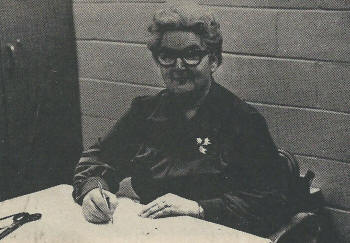Contact: Dolores (Mohr) Kenyon
E-mail: dolores@wiclarkcountyhistory.org
Surnames: Heidemann
----Source: Tribune Record Gleaner (Loyal, Clark Co., WI) 1/24/1974
Greenwood Community Elementary (24 January 1974)
Mingling with Mary (By Mary Woods)

“Individually guided education (IGE) is an education system that does not mold children to fit itself, but that molds itself to fit the needs of individual children.” That statement was made by one of two elementary, female supervisors-principals in Clark County, Mrs. Lyman (Willetta) Heidemann of the Greenwood Community Elementary School.
Beginning the principal’s role in the fall of 1964, Mrs. Heidemann has seen many changes during the past ten years. When first beginning in the Greenwood School System, the elementary, K – 8th grades, was instructed in the present day high school building with Eaton Center having two classes and Willard having three classes. The students were bused to their respective classrooms. With the ground-breaking ceremony for the present elementary school conducted in April of 1970, the use of the facilities began on Jan. 6, 1971. Prior to moving into the building, most of the plans for implementing the IGE system were developed and students had been tested and grouped according to their abilities, and needs.
At the present time, 385 students are enrolled in the elementary school at Greenwood. The students are not enrolled in specific grades, but go by groups (units) of A, B, C, D, and E. The students are able to work at their own ability and may work in a small or large group, and if needed, may work by themselves on certain projects. The average student spends seven years in the elementary school and has no set test that is taken before advancing to seventh grade. According to Mrs. Heidemann, “Testing is used as a means to find out where specific research is needed, and to see if the student has met his learning objectives and achieved them.”
According to Mrs. Heidemann, the IGE system is divided into four areas, assessment of what the student has learned, choosing the objectives, implementing the learning program, and reassessing the student so that he either pursues the objective further if necessary, or sets new objectives. The program lets the teacher look at each child’s needs on an individual basis and provides him with the needed materials, rather than comparing him to anyone else. “Using the IGE means of education, the students grow in curiosity, courage, confidence, independence, and resourcefulness, patience, competence, and understanding,” she added.
Giving an example of the means of instructing in the school, Mr. Heidemann pointed out that for penmanship class, the students write letters along with using the textbook. She pointed out that reality is used rather than artificial ways of motivating the student. “We also use a wide variety of resources such as filmstrips, tapes, and other audio-visual devices. This gives the student more was of learning, and some students do learn better by listening, watching, rather than reading; it all depends on the student.”
Within each divided group, a basic reading center is provided with a larger resource center available for the entire school. The resource center is organized under the card catalog system, with a librarian present at all times.
According to Mrs. Heidemann, the school has 21 full-time teachers, with four interns each semester. Besides the teaching staff, the school also provides numerous other instructors such as a librarian, an AV coordinator who is shared with the high school, a speech specialist also shared with high school, a school psychologist as a part-time worker, employed through CESA and a Green Thumb worker. Student teachers are also present at different times.
Asked how the students react to the IGE system of teaching, Mrs. Heidemann stated that the student is given more freedom to learn and is more capable of becoming aware of his abilities and what he must do to improve in needed areas. “The student does not become so frustrated when he works at his own speed and can review more things if needed to learn the selected materials,” remarked Mrs. Heidemann.
As to how she enjoys her work, Mrs. Heidemann stated, “I enjoy it very much, and if I didn’t, I don’t think I would have been here for the past ten years. I fill out a lot of surveys as I am concerned, the IGE system is advanced in the educational system.” Prior to taking the role of principal, she taught in rural schools in Clark County, taught seven years at the South Side Elementary School in Neillsville, and served as principal for two years along with teaching, taught at the Sheboygan County Teachers College and spent one semester as elementary supervisor at the Owen-Withee School District. She received her Bachelor’s degree from UW-Eau Claire, and a Master’s from the University of Minnesota and has done advance work at other institutions.
For Mrs. Heidemann, the teaching, supervising, and principal’s role is a challenge, and provides much reward when it comes to watching how the students do learn, and it’s all part of the Individual Guided Education System at the Greenwood Community Elementary.
